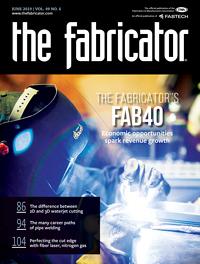Principal
- FMA
- The Fabricator
- FABTECH
- Canadian Metalworking
Categories
- Additive Manufacturing
- Aluminum Welding
- Arc Welding
- Assembly and Joining
- Automation and Robotics
- Bending and Forming
- Consumables
- Cutting and Weld Prep
- Electric Vehicles
- En Español
- Finishing
- Hydroforming
- Laser Cutting
- Laser Welding
- Machining
- Manufacturing Software
- Materials Handling
- Metals/Materials
- Oxyfuel Cutting
- Plasma Cutting
- Power Tools
- Punching and Other Holemaking
- Roll Forming
- Safety
- Sawing
- Shearing
- Shop Management
- Testing and Measuring
- Tube and Pipe Fabrication
- Tube and Pipe Production
- Waterjet Cutting
Industry Directory
Webcasts
Podcasts
FAB 40
Advertise
Subscribe
Account Login
Search
The soft side of lean manufacturing through respect and humility
Lean tools can get your organization only so far, you need to win hearts and mind
- By Jeff Sipes
- July 6, 2019
- Article
- Shop Management
Leading an organization in a lean way involves much more than just making the right technical decisions: the part flow goes this way, the batch sizes are smaller, this tool goes in this spot, and so on. I call this the “tools side” of lean. The lean tools are important, of course, but you also can’t ignore the “soft-side” issues.
If being lean were all about the technicalities, you could rule the shop with an iron fist and everyone would fall in line. But successful lean organizations understand that they must engage the entire workforce. It’s about winning over hearts and minds, and this doesn’t come by ruling with an iron fist. It comes by showing respect and humility.
The Desire for Engagement
How do you want to be treated? Probably the same way everyone else wants to be treated. If you respect people and act with humility, chances are you will be treated the same way.
Respect and humility counterbalance the tools side of lean. The tools aren’t sensitive, and they don’t have good days and bad days. The tools have no emotion—but we do. We have different feelings and expectations, and we’re not all wired the same way. Use judgment to determine the best way to interact with employees so that they do their best work and contribute to the company’s success.
Since your lean journey started, employees have learned about and acted on many lean fundamentals. 5S has improved the operation’s organization and cleanliness. Products flow in a streamlined manner. The shop operates with a distinct, defined rhythm. People know how to identify waste and reduce or eliminate it. All this is great, but there’s more to the story.
Just learning about the lean tools gets you started down the lean path—but it’s just a start. Implementing lean does not by itself lead to full employee engagement. There has to be respect and humility whether you are the owner, plant manager, supervisor, or a peer. You want employees to desire to be fully engaged in improving the business and satisfying customers. The key word is desire. When people have that internal desire, they take initiative and exhibit ownership.
Showing Respect
If you’ve spent most of your career in an industrial environment dominated by top-down, authoritative, just-do-your-job management, then shifting to a respect-and-humility way of behaving can be challenging. And it’s personal. “The organization” does not act with respect and humility. You do.
Know that your people come to work every day, buckle down to the job, and do that job every day, all day. If you give them the proper training, tools, and procedures, then they should be able to get the job done. Again, that’s the “technical side” of things—the nuts and bolts of how people do what they do.
But how are people treated over a day, week, or year? Are they treated as cogs in a gear, or are they treated in a way that acknowledges their value, capability, and desire? Respect for people shows up in the way you treat the employees.
So what does this look like? How do you “build” respect and humility, exactly? To illustrate, let’s focus on John, a shop welder. Imagine you’re John’s supervisor. John knows how to do his job, because you’ve provided training, tools, and procedures (and you have, right?). Assuming you’ve done this, how do you interact with John?
First, you treat John as a skilled person who knows what he’s doing. If John produces a weld with excessive undercut or other defect, don’t just throw up your hands and assume John doesn’t have the skill or talent he needs to be a good welder. Ask him what happened.
This leads to the second point: Seek John’s input on matters within his scope of control. If you never ask for John’s input, you’ll probably never solve the problem completely. You might solve the technical side of the problem—be it related to equipment, filler metal, bad part design, or anything else—but it doesn’t solve the soft side. Asking for input matters.
Next, listen to what John has to say. Back to that weld undercut issue, John could have just had a bad day. But perhaps there was a problem with the weld preparation or other upstream process. Or maybe there was an issue with the welding procedure, or perhaps the specified filler metal. You don’t need to ask about these specifics—just listen. Again, John works in this welding cell all day, so when it comes to the details about what happens in that cell, he’s the expert, not you.
During all this, recognize John’s capabilities in such a way that John realizes you recognize them. He does so because you didn’t berate him or tell him he should have known better. You didn’t bark orders. You listened and tried to help. You helped John understand that he is more than “arms and legs.” He’s a valued part of the end-to-end process.
Showing Humility
Humility complements respect. If a person, particularly a leader or supervisor, acts like a know-it-all, it’s hard to take that person seriously.
Even if you do know it all (and let’s face it, you don’t), stop and think about how you come across to people. A certain amount of humility goes a long way toward creating an environment where everyone is considered a valuable contributor.
Humility requires people to reflect about how they interact with others and how others perceive them. Sometimes, even with the best of intentions, know-it-alls can really tick other people off—and with that they lose effectiveness.
Being humble does not mean you give up your ability or responsibility to lead, nor does it mean you become milquetoast. Rather, with humility you can become a more effective leader (wherever you are in the organization) by helping others to achieve their potential and by sharing the spotlight when things go well. When people line up behind you because they want you to succeed, you are more likely to succeed.
Winning Hearts and Minds
The tools side of lean manufacturing gets you only so far. Those who balance the tool side and soft side of lean often achieve the best operational performance and create the most vibrant and sustainable improvement engines.
Take a hard, introspective look. Are you leading in a way that gets a willing workforce to put lean tools to work? Or are people dragging behind? Think about your ideal boss. How would that person behave, and are you behaving in that same way?
Observe how others behave. Do they show respect and act with humility? Or do they say one thing and then do something else? Perhaps you can coach them to help them be more effective players in your company’s lean journey.
Finally, define how your company “behaves.” Yes, a company is a collection of individuals, but the collective company has its own identity and personality. Define your company’s personality by drawing from all perspectives, including those from leadership, middle management, and front-line employees. Those perspectives might not align; in fact, they might differ much more than you expect. If they do, then make sure that issue gets front-and-center attention.
If you respect people and act with humility, you will set a positive tone for the organization. Find that balance between the tools side and soft side of your lean journey. Set the bar high, and you’ll engage hearts and minds.
Jeff Sipes is principal of Back2Basics LLC, 317-439-7960, www.back2basics-lean.com. If you have improvement ideas you’d like to read about, email him at jwsipes@back2basics-lean.com or Senior Editor Tim Heston at timh@thefabricator.com.
About the Author

Jeff Sipes
9250 Eagle Meadow Dr.
Indianapolis, IN 46234
(317) 439-7960
subscribe now

The Fabricator is North America's leading magazine for the metal forming and fabricating industry. The magazine delivers the news, technical articles, and case histories that enable fabricators to do their jobs more efficiently. The Fabricator has served the industry since 1970.
start your free subscription- Stay connected from anywhere

Easily access valuable industry resources now with full access to the digital edition of The Fabricator.

Easily access valuable industry resources now with full access to the digital edition of The Welder.

Easily access valuable industry resources now with full access to the digital edition of The Tube and Pipe Journal.
- Podcasting
- Podcast:
- The Fabricator Podcast
- Published:
- 04/16/2024
- Running Time:
- 63:29
In this episode of The Fabricator Podcast, Caleb Chamberlain, co-founder and CEO of OSH Cut, discusses his company’s...
- Industry Events
16th Annual Safety Conference
- April 30 - May 1, 2024
- Elgin,
Pipe and Tube Conference
- May 21 - 22, 2024
- Omaha, NE
World-Class Roll Forming Workshop
- June 5 - 6, 2024
- Louisville, KY
Advanced Laser Application Workshop
- June 25 - 27, 2024
- Novi, MI
































